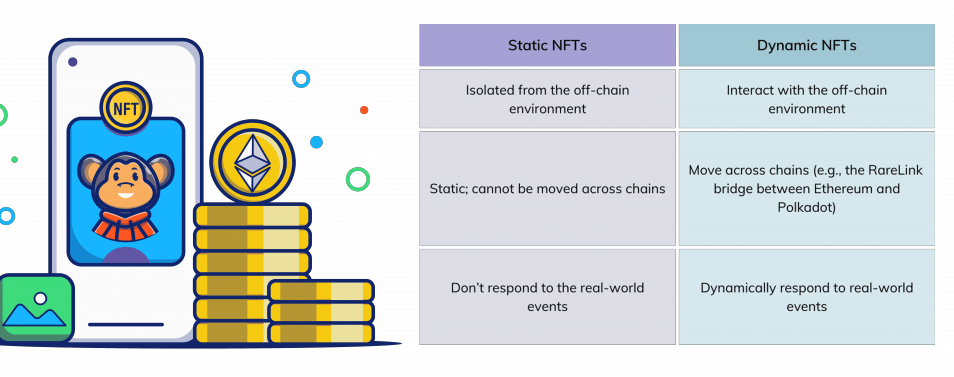As non-fungible tokens (NFTs) continue to rise, their applications and functionalities expand. As such, there is increasing discourse about a fresh breed of NFTs referred to as dynamic NFTs. In contrast to static NFTs, they are capable of changing over time.
Keep reading to learn all about the differences between these two types of NFTs, and what makes dynamic NFTs stand out:

A Comparison of Static and Dynamic NFTs
Static NFTs are unable to alter once minting to a blockchain network. Therefore, the associated data, like artwork or music tracks, stay the same, even when switching ownership. Likewise, GIFs and videos can also be considered static NFTs as long as the image or video file remains the same after minting.
On the other hand, a dynamic NFT, otherwise known as a “living NFT”, can alter depending on external factors, like an event or an achievement. For example, a metaverse gamer’s avatar may change as the player progresses through the game.
Accordingly, dynamic NFTs can be altered after minting. This typically occurs by changing the NFT’s metadata, such as it name, content, traits, description, transaction history, etc. As a result, the token’s appearance may also change. The data being modified is usually stored off-chain in a JSON file and requires knowledge of code for modification. Thus, it can be a time-consuming, complicated process.
Technicalities Behind Dynamic NFTs
Dynamic NFTs store data in an editable format. Such digital assets utilize the ERC-1155 token standard rather than the ERC-721 standard for static NFTs. The ERC-1155 standard is “semi-fungible,” so it allows for necessary alterations.
Modifications to dynamic NFTs can quickly commence through a smart contract. An oracle typically sends external data to the smart contract, which triggers a change in the NFT’s metadata. This update affects the token’s characteristics alongside its appearance.
Examples of Dynamic Digital Assets
To give a wider understanding, there are plenty of dynamic examples. Let’s look at the popular NFT-based game, Cryptokitties, for instance. Gamers have the opportunity to buy, sell, or breed virtual felines. Each cat is a dynamic NFT, therefore, allowing owners to alter certain aspects of the associated data. This includes the cat’s genes, temperament, and characteristics.
Another fantastic example is Mike Winkelmann, aka Beeple’s “Crossroad“. The dynamic NFTs were created in 2020, before the US presidential election, to change their appearance depending on the result. However, to put a humorous spin on things, once Joe Biden became president, the image switched to President Donald Trump laying in a heap over losing the election.
In Short – the Need for Changeable NFTs
Dynamic NFTs are a fantastic development in the NFT world that provides a flexible and versatile option for digital assets. While static NFTs remain the same for digital collectibles and art projects, dynamic NFTs are fantastic for play-to-earn games to entice gamers with frequent updates.
As the Web3 world continues to evolve, dynamic NFTs will likely play an increasingly significant role in shaping the evolution of digital assets and Web3.
Subscribe to the NFT Lately newsletter to receive news covering the latest NFT-related drops, releases, reviews, and more.



